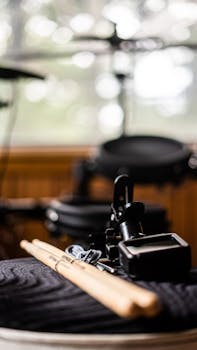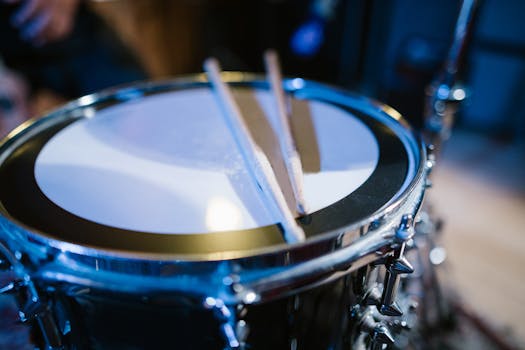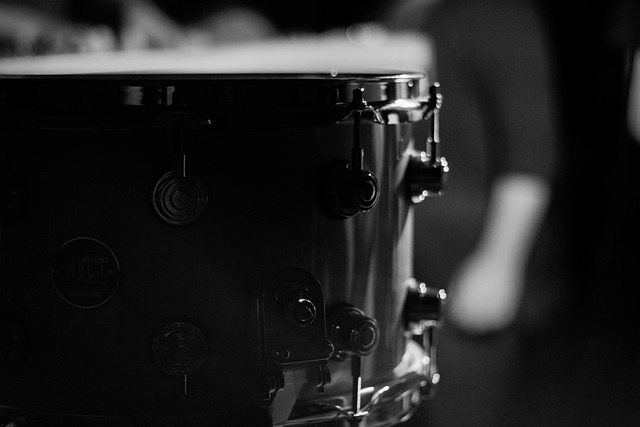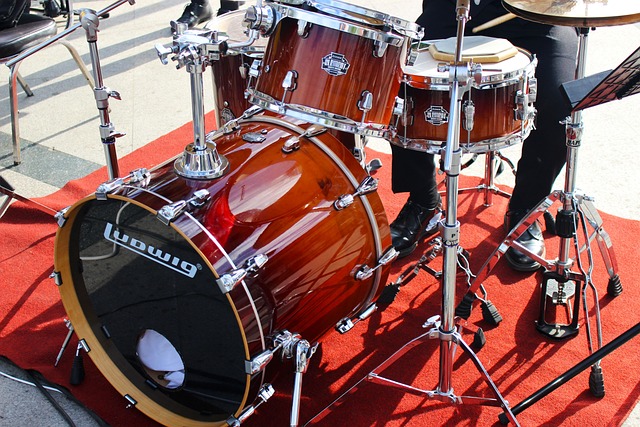Drum Set Sticks
How to Care for Your Drum Sticks
Caring for your drum sticks is essential for maintaining their performance and longevity. First, always store them in a protective case or bag. This prevents them from getting damaged or warped when not in use. I personally recommend getting a stick bag that allows you to easily organize various pair lengths and types, as it keeps them safe and ready to grab.
Next, avoid exposing your sticks to extreme temperatures and humidity. These conditions can cause the wood to expand or crack. I keep mine in a climate-controlled environment where possible. If you’re practicing outdoors, try to bring them inside after your session.
Regular inspection of your drum sticks is critical. Check for signs of wear like chips, splinters, or warping. If you notice any damage, it’s time for a new pair. Using worn-out sticks can affect your playing, leading to unwanted sounds and even injuries.
Another tip is to rotate your drum sticks. If you play a lot, you’ll find that one stick often wears down faster than the other. By rotating them, you distribute the wear evenly. This will help prolong the life of your sticks and maintain a consistent feel.
Cleaning your sticks also contributes to their lifespan. After playing, I typically wipe them down with a soft cloth to remove dirt and moisture. This simple act can prevent corrosion and build-up that can affect their grip and performance. Avoid using any strong chemicals or cleaners; a damp cloth does the job just fine.
If you play with a lot of intensity, consider experimenting with different wood types or stick models that suit your style better. For instance, hickory is more durable than maple, but I often find maple provides a lighter, more responsive feel for softer playing. Finding the right sticks tailored for your style can significantly enhance your experience.
Finally, take note of how often you replace your sticks. Having a stockpile of your favorite models allows you to play without interruptions. It can be frustrating to realize that the perfect pair of sticks is broken right before a gig.
Common Materials Used in Drum Sticks
Drum sticks are crafted from various materials, each influencing the sound and feel of the music. Here’s a quick overview of the most common materials used.
- Hickory: This is the gold standard for drum sticks. With its excellent shock absorption and resilience, hickory sticks feel right at home in any drummer’s hands.
- Maple: Lighter and softer than hickory, maple is perfect for those tender jazz touches. The reduced weight means quicker play, but it sacrifices some durability.
- Beech: Known for its stiffness, beech can take a beating while delivering a solid attack. Perfect for hard-hitting players who still appreciate a balanced tone.
- Acrylic: These sticks offer a unique visual appeal, often with vibrant colors. However, they sound different and can be harsher on drum heads, which can be a dealbreaker for some.
- Oak: Heavier than hickory and maple, oak offers durability and a bright sound. If you want stick control with extra weight, oak is your friend.
- Carbon Fiber: A modern option that’s gaining traction, carbon fiber sticks are incredibly durable and can withstand aggressive playing without warping.
PERFORMANCE WITHOUT LIMITATION…BY DESIGN. For nearly 60 years, we at the Vic Firth Company have focused on developing and manufacturing what has become the …
Vic Firth | Official Site | Drumsticks, Mallets and Branded Apparel
Jun 11, 2020 … I own and have used the vic firth roger carter sticks, and it's cool that it is a marching stick that has the feel of a drumset stick.
Is there a drumset stick that feels like a marching stick? : r/drumline
ProMark Drumsticks. ProMark sticks are made for those who march to the beat of their own drum. We're the official stripes of extending the solo and throwing …
Shop the official Zildjian online store, featuring cymbals, drumsticks, and percussion mallets.
Narada Michael Walden Fan Page. Aug 20, 2020 · . Timeline photos. Drum sticks of love ❤️. 126. 126. 5. . Terrence Paul Miller. Right on. 4 yrs.
Consider your playing style: rock, jazz, etc.
Understanding your playing style can greatly influence the choice of instrument and technique. Here are key considerations for various styles.
- Rock enthusiasts often favor electric guitars with powerful pickups and distortion effects.
- Jazz players typically prefer smooth, warm sounds from instruments like saxophones or upright basses.
- Classical musicians usually lean towards traditional instruments such as grand pianos or violins for their rich tonal capabilities.
- Folk and acoustic lovers find joy in using guitars and mandolins that complement storytelling through music.
- Contemporary musicians might opt for electronic instruments, combining elements from various genres for a unique sound.
- Each style demands a different approach to technique, so choose an instrument that resonates with your musical preferences.
- Consider the genre’s community and culture, as these can influence your musical expression and collaboration opportunities.
Essential Techniques for Stick Control
Stick control is the cornerstone of proficient drumming. My experience shows that without mastering this skill, you’ll struggle to progress, no matter the genre or style you’re pursuing. Here are some crucial techniques that can drastically improve your stick control.
First, practice basic rudiments regularly. These include the single stroke, double stroke, and paradiddle. Rudiments serve as the building blocks of drumming; their mastery translates into greater fluidity and precision. I recommend spending at least 15 minutes daily focused solely on these patterns.
Next, prioritize grip and positioning. Look for a comfortable grip that balances control and relaxation. A loose grip allows for better rebound and stick bounce, which is essential for maintaining speed without unnecessary tension. Experiment with different grips to find what feels best for you while ensuring your forearms and wrists are relaxed.
Also, incorporate dynamics into your practice. Playing soft and loud, or varying your hits during the rudiments, teaches greater control. Dynamic range not only improves stick control but also adds emotional depth to your playing.
Furthermore, use a metronome diligently. Start slow to ensure accuracy, and gradually increase the tempo as you become more comfortable. Playing in time enhances your stick control significantly, as it forces you to maintain consistency while focusing on precision.
Finally, integrate some form of physical conditioning to strengthen your wrists and forearms. Exercises like wrist curls or using wrist rollers can help build the necessary muscles for better control. A strong wrist and arm contribute to cleaner and more explosive hits.
Stick control is a lifelong pursuit, but mastering these techniques can dramatically elevate your drumming skills.
Types of Drum Sticks: A Comprehensive Guide
Choosing the right drumsticks can dramatically alter your playing experience, allowing for precision and expression. There are several types of drumsticks, each suited for different styles, genres, and personal preferences.
Wooden drumsticks are the most common type. Within this category, you’ll find various wood types, with hickory and maple being the most popular. Hickory is rugged and offers a balance of resilience and weight, making it ideal for various musical situations. Maple is lighter and provides a different feel, which is particularly suitable for softer playing or jazz. The choice between these woods boils down to your playing style.
Drumstick sizes are denoted by a combination of a number and a letter (e.g., 5A, 7B). The number indicates the stick’s diameter, while the letter denotes its taper and shape. Larger numbers typically indicate thinner sticks, while letters like ‘A’ are often used for general playing and ‘B’ is popular in rock and heavier styles. Finding the right size is crucial for comfort and speed.
Drumsticks also come in various tip shapes: round, oval, and teardrop, each producing different sounds on drum surfaces. For example, a round tip offers a clear sound, while a teardrop tip provides extra surface contact for a broader tone. This choice can significantly affect your sound, especially when playing a particular piece.
For drummers who enjoy exploring diverse sounds, specialty sticks made of different materials like nylon or made to resemble brushes can be an option. Nylon tips produce a bright sound, while brushes offer a unique swishing effect ideal for softer genres. Experimenting with these can lead to exciting musical discoveries.
The choice of stick is also influenced by personal comfort. Some drummers might prefer a heavier stick for power, while others gravitate towards lighter options for speed. Your grip and hand size can also dictate your preference. It’s essential to try various sticks to see what feels most natural in your hands.
Ultimately, investing some time in trying different types of drumsticks can enhance your performance and enjoyment of playing. The right pair can complement your technique and help you achieve your desired sound. So don’t hesitate to explore the diverse offerings in the market!
Experiment with different weights and lengths
Exploring various weights and lengths can considerably impact your musical experience and performance.
- Choosing the weight of an instrument affects playability; heavier instruments often produce a fuller sound, while lighter ones can be easier to handle.
- For string instruments, experimenting with string gauge or tension reveals how weight impacts tone; thicker strings typically offer a richer quality.
- In woodwinds, the length of the instrument directly influences pitch; longer instruments generally produce deeper sounds.
- For percussion, different mallet weights impact dynamics—heavier mallets bring out more volume, whereas lighter mallets allow for subtlety.
- Electric guitars can be altered by changing the weight of the body or the scale length, affecting sustain and tonal characteristics.
- When trying out instruments in stores, don’t shy away from testing models that differ in weight and size; this hands-on practice is invaluable.
- Consider how different weights and lengths change your comfort; finding instruments that suit your physicality can elevate your playing experience.
Upgrading Your Stick: When and Why
Upgrading your musical instrument, especially sticks used in percussion, is a decision that shouldn’t be taken lightly. As a drummer, I’ve often felt the need to switch to better sticks, and there are clear indications and reasons for doing so. First and foremost, consider the wear and tear on your current sticks. If you notice significant dents, splinters, or if they’ve lost their overall balance, it’s time to upgrade. Playing with compromised sticks can lead to poor performance and even injury.
Another significant factor is your playing style. If you’ve evolved as a musician, your sticks should follow suit. Transitioning from lighter jazz playing to heavier rock demands a different type and weight of stick. Pay attention to how your current sticks feel—if they’re not complementing your style, consider trying out newer models that offer better grip and weight distribution for your needs.
The sound produced by your sticks is crucial as well. Over time, certain sticks may no longer resonate well with your drum set, leading to a dull or uneven sound. If your sound lacks depth or clarity, upgrading sticks can revive your tone. Experimenting with various materials—like maple versus hickory—can enhance your sound significantly.
Moreover, advancements in technology and materials mean newer sticks might offer features you didn’t have access to before. Perhaps you want a stick that reduces vibration or enhances durability. Researching options can reveal sticks designed specifically for the needs of modern drummers, making your playing experience smoother.
Ultimately, trust your instincts. If you feel that the current sticks limit your potential or creativity, do not hesitate to explore better options. Upgrading them can lead to a more enjoyable playing experience and help hone your skills further.
Check the grip and comfort level
Assessing grip and comfort is essential for optimal performance on any instrument.
- Choose instruments that fit comfortably in your hands. Instruments should feel natural to hold, reducing strain during play.
- Examine the shape of the neck on guitars and basses. A slim neck versus a chunky one can drastically affect your playing experience and technique.
- For woodwinds, mouthpiece shape and reed stiffness matter. An overly harsh setup can turn a beautiful experience into frustrating discomfort.
- Evaluate the key placement on keyboards and pianos. Keys should be easily reachable, allowing you to play without straining your wrists or fingers.
- Consider strap comfort for stringed instruments. A well-padded strap can make a significant difference, especially during long practice sessions.
- Remember that personal preference plays a huge role. Everyone’s grip varies, so cross-compare with others to discover what feels right for you.
Choosing the Right Drum Sticks for Your Style
The right drumsticks can completely transform your playing experience. For me, the journey began with trial and error, trying out various sizes, shapes, and materials until I found my perfect match. First, consider the size of the stick. Stick sizes are denoted by a number and letter combination. A stick labeled as 5A or 7A is typically a safe choice for beginners; lighter and smaller, they offer better control. However, if you prefer a heavier approach with powerful strikes, opt for 2B or 5B sticks. These produce a louder sound and are suitable for rock and heavier genres.
Then there’s the tip shape—wooden tips tend to create warmer sounds while nylon tips provide a brighter tone with added durability. For jazz enthusiasts, a stick with a smaller, teardrop tip offers precision and articulation. If you’re playing metal or rock, a pair with a larger, round tip can produce a more aggressive sound. Check the weight of the stick as well; heavier sticks can deliver more force behind your notes but can be tiring over long sessions.
Wood type is another essential aspect. Hickory is the most common because it’s resilient and absorbs shock well. Maple sticks, being lighter, offer quicker movement for fast-paced playing but may wear down faster. I lean towards hickory for its balance of durability and feel, especially during longer performances.
Don’t underestimate the grip. Some companies offer drumsticks with unique texture materials or grip coatings that can enhance feel and reduce slippage. Consider your playing style; if you play with high energy and sweat a lot, a better grip can significantly improve your control.
Ultimately, if you’re exploring different genres, investing in a few types of sticks can pay off. Experimentation is key—what works for one style may not feel right for another. So, hit those drums with confidence and let your personal style shine through.
Tips for Beginners: Finding Your First Pair of Sticks
Choosing the right pair of drumsticks is essential for your comfort and performance. I remember standing in a music store, looking at countless options and feeling completely lost. So let’s break it down into manageable steps. First and foremost, consider the size and weight of the sticks. Generally, the larger the number, the thinner the stick—like 5A being more popular for beginners. I found that a good starting point is a pair marked 5A or 5B, balancing weight and ease of use.
Material matters. Most sticks are made from either hickory or maple. Hickory is denser and absorbs shock well, which I found to be great if you’re learning to play harder styles. Maple, on the other hand, is lighter and offers a faster feel, perfect for more delicate playing like jazz. Think about what music you aim to play as it impacts your choice significantly.
Next, the tip shape makes a difference. Rounded tips produce a warmer sound, while acorn tips can give you clarity. For beginners, I recommend sticking with a round tip to help with versatility.
Don’t forget about grip! Many sticks have a finish that affects how they feel in your hands. Some are varnished, while others have a raw feel that can prevent slipping. Personally, I preferred raw sticks because I felt more connected to my play. Check for gripping areas, as they can also aid in preventing unwanted slips, especially during long sessions.
Finally, budget is always a reality. Good drumsticks don’t have to be expensive. I found solid pairs for under $10 that lasted me through countless practice sessions. If possible, try a few sticks in-store to see how they feel before committing to a purchase. The right sticks can boost not just your performance but also your enjoyment. You’re going to be spending hours with these, so choose wisely and have fun with the process!
Understanding Stick Sizes and Their Effects
Choosing the right stick size can significantly influence your playing experience and the sound you produce. The length and thickness of a stick can alter your grip, your ability to control the stick, and even the tone of your instrument. For instance, longer sticks generally provide greater reach and leverage, which can be advantageous in playing techniques that require greater force. However, they can also tire you out more quickly, particularly in extended sessions.
On the other hand, shorter sticks offer more precision and can facilitate intricate movements. Many drummers that specialize in detailed rhythms prefer shorter sticks for their control and maneuverability. Thickness is another crucial variable; thicker sticks tend to produce a fuller sound, while thinner sticks often create a brighter, sharper tone. This is particularly evident in genres like rock or jazz, where the dynamics can hinge on the type of sound you want to create.
When experimenting with stick sizes, consider how the material influences performance as well. Wood vs. synthetic materials can have major implications. Wood, for instance, offers a warm sound but may wear down faster, while synthetic options are often more durable but could provide an altered tonal quality. Ultimately, the choice in stick size should reflect not only your musical style but also your physical comfort and technical abilities. Finding the perfect stick is a highly personal journey; one person’s preference can be entirely different from another’s. Don’t hesitate to try different sizes and shapes to discover what resonates with you.
The Impact of Material on Stick Performance
The choice of material for sticks is crucial and can dramatically influence the performance of musical instruments. Different materials offer varying levels of durability, weight, and resonance, directly affecting playability and sound quality. As a drummer, I’ve noticed the stark differences between wood, nylon, and other synthetic materials when striking a drum head or cymbal.
Wooden sticks, often made from hickory or maple, provide a warm, natural sound that many percussionists prefer. Hickory is known for its resilience and shock absorption, making it ideal for heavy hitters. Maple, being lighter, offers a brighter sound but less durability. I’ve always gravitated towards hickory sticks for their balance and ability to withstand rigorous play.
On the other hand, nylon-tipped sticks tend to produce a sharper, more pronounced attack, particularly on cymbals. The synthetic material ensures less wear and tear, which can be beneficial for those who perform frequently or in high-energy environments. However, they may not absorb shock as effectively as their wooden counterparts, which can lead to quicker fatigue during extended sessions.
Additionally, weight plays a significant role. Heavier sticks can generate more force, ideal for hard-hitting styles, while lighter sticks can facilitate faster playing and greater agility. Through personal experimentation, I have found that the combination of material and weight should align with my playing style and the genre of music I’m engaging with.
Finally, some manufacturers introduce hybrid materials, blending wood with composites or plastics. These innovative sticks can offer a unique blend of qualities, potentially providing the best of both worlds. Ultimately, the impact of material on stick performance is not just about sound; it’s about the drummer’s comfort and connection with their instrument.
Drum Stick Brands to Consider
Finding the right drumsticks can transform your playing experience. Some brands stand out for their quality, variety, and player preference. Vic Firth is a name that resonates with drummers of all skill levels. Their sticks are known for consistency, balance, and durability. I personally adore their American Classic series, which offers a range of models to suit different styles and genres.
Another brand that I cannot overlook is ProMark. They provide a brilliant selection of materials and stick types. Their Shira Kashi Oak series features heavier sticks that produce a powerful sound, perfect for rock drumming. I often reach for these when I’m looking to pack a punch in my playing.
For those interested in eco-friendly options, VF**’s 3D Drumsticks are crafted from sustainable wood sources. These sticks not only feel good in hand but also align with a more sustainable approach to music.
Let’s not forget Ahead. Known for their innovative aluminum sticks, they offer a unique playing experience. While they might not be for everyone, I find them useful for specific genres and styles due to their innovative design and durability.
Lastly, Zildjian, primarily known for cymbals, has an impressive range of drumsticks that can’t be overlooked. The Zildjian Anti-Vibe series has become a favorite of mine for its vibration-dampening technology—great for long practice sessions.
Choosing the right brand often comes down to personal preference and playing style. I encourage trying sticks from various brands to find what feels best for you.
Top 5 Drum Stick Brands to Try
Explore some of the finest drum stick brands I’ve come across during my musical endeavors.
- Vic Firth: This brand is synonymous with quality. I swear by their American Classic series, which offers various models tailored to different playing styles. The feel and balance are unmatched.
- ProMark: Known for their innovative designs and quality craftsmanship, ProMark offers an impressive range, including specialty sticks like the Hot Rods that I have found excellent for softer playing.
- Regal Tip: Their signature model is preferred by many professionals. I’ve enjoyed their unique brush sticks, which provide an alternative sound that’s perfect for lighter music.
- Ahead: These sticks are revolutionary with their aluminum core and replaceable nylon tips. I appreciate the longevity and durability they offer, especially during rigorous practice sessions.
- Zildjian: Famous for their cymbals, Zildjian also makes excellent sticks. Their models are well-balanced, and I find their maple sticks particularly comfortable for extended play.
As an Amazon Services LLC Associates Program participant, we earn advertising fees by linking to Amazon, at no extra cost to you.
How often should I replace my drum sticks?
Replacing your drum sticks depends largely on your playing style, frequency of use, and the type of sticks you use. If you’re a heavy hitter or play regularly, you might need to replace your sticks every few weeks. Grinding down visible tips or cracks in the wood indicates it’s time for a change. If you play more casually, sticks can last several months. Experimenting with different materials like hickory or maple can also affect longevity. Listen to your sticks; if they don’t feel right or produce a poor sound, they’re likely past their prime. Some drummers prefer to have several pairs on hand to switch between them based on wear. Ultimately, paying attention to your sticks’ performance is key in deciding when to replace them.
What type of drum sticks should I use for different genres?
The choice of drum sticks is crucial and varies dramatically by genre. In rock music, I always reach for sticks made of hickory or maple, generally heavier (like 2B or 5B) to deliver loud, powerful hits. For jazz, thinner sticks, around 5A or 7A, offer better control and a lighter touch, which is essential for intricate patterns and brushes. If you’re into funk, consider using nylon-tipped sticks for a sharper attack on cymbals. For metal, grab the heaviest sticks you can handle. A 2B works wonders in generating aggressive sound on the kit. Punk demands a similar approach, but don’t shy away from experimenting with lighter models to maintain speed without losing punch. Lastly, in orchestral or classical settings, a longer stick with a thicker neck (like a 7A) provides sensitivity for dynamic playing with softer hitting. Ultimately, your stick choice can have a significant impact on your sound and style.
Can the weight of the sticks affect my playing?
Absolutely, the weight of drumsticks can significantly change your playing experience. Heavier sticks generally produce a louder sound and may require more effort to control, which can be tiring over long sessions. On the flip side, lighter sticks offer more speed and agility, but can lack the same volume and power needed for certain styles. Finding the right weight is crucial for achieving your desired sound and feel. I’ve found that heavier sticks can give a fuller tone on harder hits, while lighter ones are perfect for intricate patterns or faster tempo pieces. Moreover, personal preference plays a major role; some drummers thrive with heavier sticks while others feel more comfortable with lighter ones. Experimenting with different weights can help you discover what feels best for your playing style and musical genre. Ultimately, the right stick weight complements your technique and enhances your overall performance.
What are the differences between wood and nylon sticks?
Wood and nylon sticks each offer distinct sound qualities and playing experiences. I find that wood sticks, often made from hickory or maple, produce a warmer and more natural tone. They tend to have a subtle flexibility that adds character to the sound, making them great for genres where nuance is key.
On the other hand, nylon sticks create a brighter, more pronounced sound. The hard surface of nylon provides a snappier attack and greater durability. They’re ideal for louder settings or when you need to cut through the mix, like in rock or pop music.
Another difference is wear and tear; wood sticks are more prone to breakage, while nylon sticks can withstand heavy use without fraying as quickly. However, I’ve noticed that nylon tips can feel less comfortable when playing on certain drum surfaces.
Ultimately, the choice boils down to personal preference and the specific sound I want to achieve. Experimenting with both will reveal their unique advantages and help inform your playing style.
Why do some professional drummers prefer specific brands?
Personal connection and sound quality drive brand loyalty among professional drummers. Each drummer has a unique style and sound they pursue, and certain brands deliver that better than others. For instance, I gravitate toward brands that offer a specific tonal character or feel that resonates with my musical approach.
Reliability and consistency are also crucial. When I find a brand that consistently produces high-quality drum kits or cymbals, I stick with it. Brand reputation built over years often reassures me that I’m investing in an instrument that won’t let me down in session or performance.
Additionally, endorsements influence choices. Seeing my drumming idols use specific brands often prompts me to try them. The endorsement deals aren’t just about marketing; they reflect genuine trust in the product’s performance. Choosing a brand with professional endorsements can feel like connecting to a larger drumming community.
Ultimately, it’s a mix of sound, feel, reliability, and a sense of belonging that shapes a drummer’s brand preference.
Choosing the right drum sticks can significantly enhance your performance. The weight, material, and thickness define not only your sound but also your comfort and control while playing. I personally feel that experimenting with different sticks transforms my drumming experience.
The choice of material drastically influences the sound produced by drumsticks. Wooden sticks offer warmth and resonance, while nylon-tipped varieties deliver sharp, articulate attacks. How these sticks feel in hand can vary significantly too, impacting your comfort and playability.
Caring for your sticks extends their lifespan. Regular cleaning and proper storage prevent wear and tear, ensuring optimal performance. Damage from moisture or improper handling can diminish their quality quickly. Treat them well, and they’ll serve you longer.
Control and technique are essential for effective drumming. Mastering these elements allows drummers to execute complex rhythms cleanly and consistently. With a solid foundation in control, you’re equipped to explore various styles and dynamics in your playing.
**The size of your drumsticks dramatically affects your playing style.** Lighter sticks allow for faster playing but require more precision, while heavier sticks provide power and a fuller sound. **Choosing the right size can transform your performance.**
As an Amazon Services LLC Associates Program participant, we earn advertising fees by linking to Amazon, at no extra cost to you.







